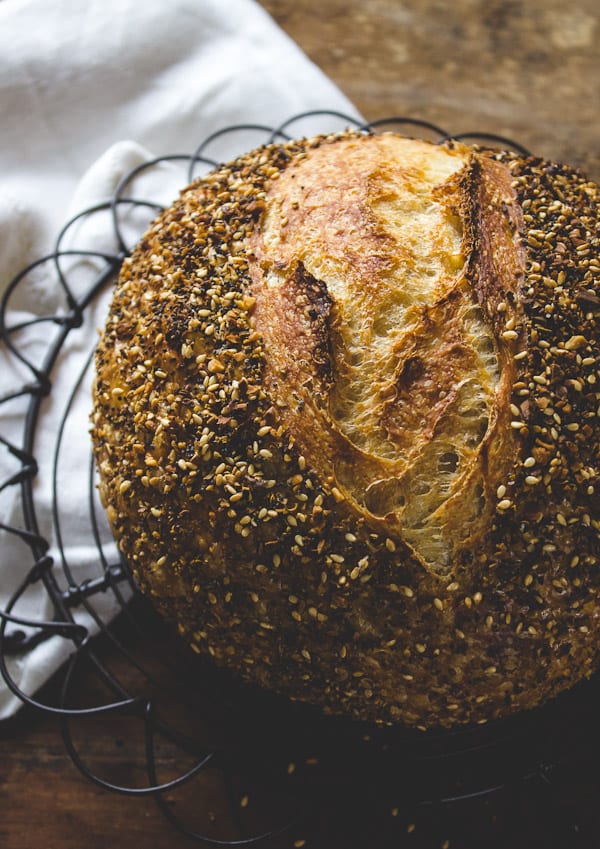
Current obsession: dukkah.
My first introduction to dukkah was in South Africa, back in 2007. Did I ever tell you that my husband is from there? Yes, he hails from the land of lions and wildebeest (bet you didn’t know how to spell that).
Anyway, we were grabbing a bite at a local restaurant where they served us dukkah, bread and olive oil as a prelude to our meal. At the time, I had absolutely no clue what it was but quickly learned that this complimentary nibble was quite common throughout the country.
So what is dukkah, exactly?
Pronounced ‘doo-ka’ it’s an Egyptian spice blend made up of toasted nuts and seeds. It reminds me of an everything bagel, minus the onion (and the bagel). The idea is to dunk your bread in olive oil first, and then swipe it through the dukkah. It’s nice and crunchy and has a wonderfully unique flavor.
Fast forward to present day and a new thought: let’s bake it on the bread.
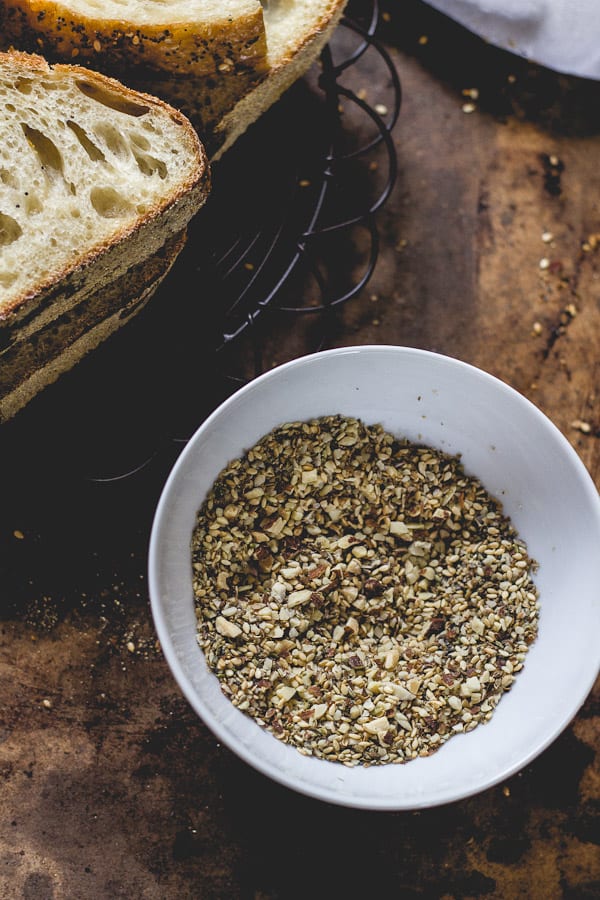
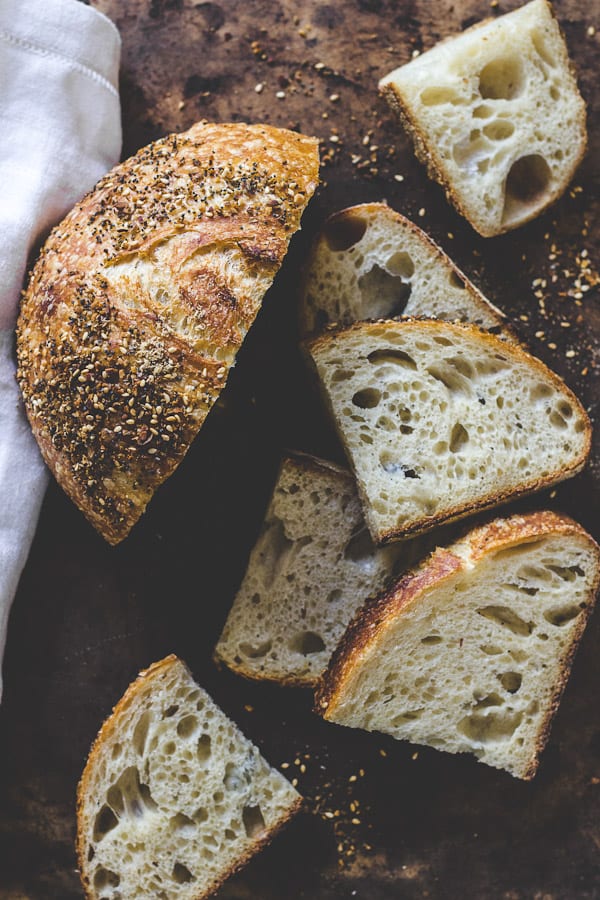
The concept of dukkah might seem a bit foreign to you, but it is very easy to make at home.
All you need is a food processor. I prefer making it myself because most store-bought blends are a little too cumin heavy for my taste.
In fact, I leave out the cumin altogether in my recipe. It gets an Italian upgrade with some fennel seeds instead.
For the sourdough, here is the breakdown:
- 50/50 whole wheat + bread flour starter (100% hydration)
- 1 hour autolyse
- Salt added after autolyse
- Stretch and fold every 30 minutes for 2 hours
- Bulk ferment at room temperature (currently 72+ F), about 5- 6 hours
- Refrigerate overnight for 2nd rise
- Rest dough for 1/2 hour, then slash
- Bake in Dutch oven @450 F for 20 minutes (covered) + 40 minutes uncovered
- Crack open the oven door during the last 10 minutes of baking to harden the crust
To clarify this crazy bread talk, please visit my beginner’s guide for all things sourdough.
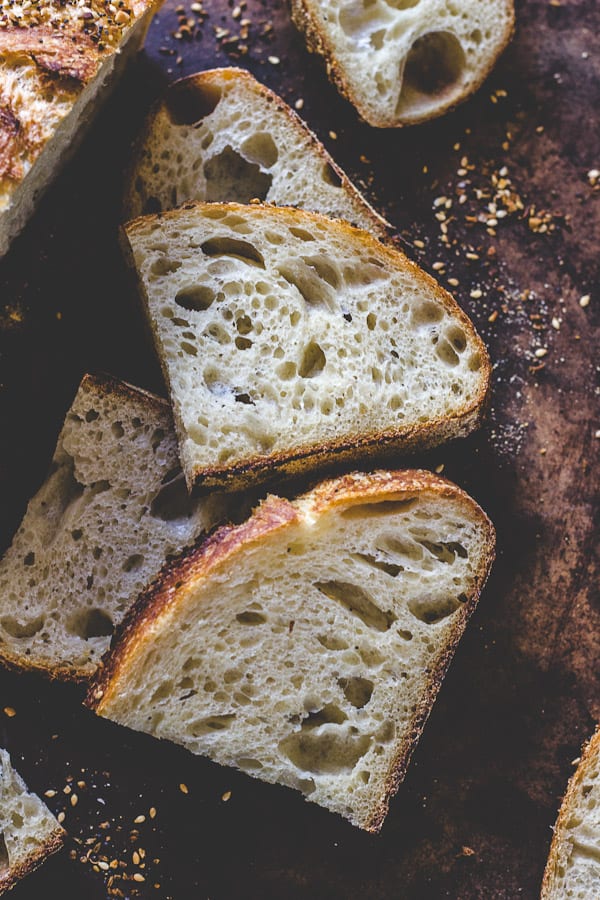
I had my best friend read this post prior to publishing, and she asked me flat out- so what’s the point of baking it on the bread? Why not just dunk?
Good point.
Here’s why: because you get to do things like toast it golden, rub it with garlic, and then submerge its crunchy goodness into soup….
You get to make sandwiches stacked with grilled chicken, tomato and avocado that will change your life…
You get to enjoy them as croutons, where their final destiny could only be a bed of crunchy greens with lemony caesar dressing… (catch my drift?)
The seeds and spices create this harmonious paring that’s different from the usual bread-dunking suspects. I will warn you though, the dukkah will fly all over the place when you try to cut the bread!
But that’s ok, just rip off a chunk and do this…
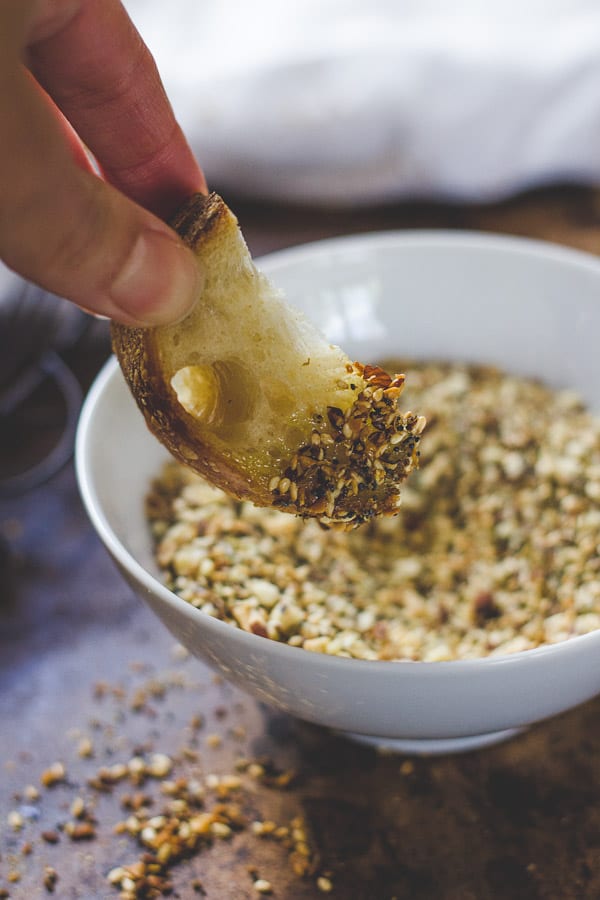
You see? We’ve now come full circle.
Tips:
- Store your dukkah in an air-tight container in the fridge or freezer until ready to use.
- Save any dukkah seeds that fall off your bread when slicing. Sprinkle them on salads, soups and croutons.
- I like to bake my bread dark, which means that the almonds will get pretty toasty (which I don’t mind). You can always reduce the oven temperature to control the browning rate. Bake at 450 F for 20 minutes (covered), and then lower the temperature to 400 F. Continue to bake for an additional 40 minutes until golden (uncovered).
- This bread is best if consumed within the first 1-2 days of baking. If you prefer, you can cut the dough in half to make 2 small loaves. Eat one + freeze one.
- To freeze, wrap your bread in plastic wrap and then in foil. It should last up to 3 months.
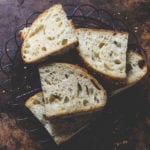
Dukkah Sourdough Bread
Ingredients
For the Dukkah
1 cup whole almonds
¼ cup fennel seeds
¼ cup coriander seeds
½ cup sesame seeds
1–2 tbsp. poppy seeds
For the Dough
150g bubbly, active starter
350g water, preferably filtered
500g bread flour (not all purpose)
9g fine sea salt
fine ground cornmeal, for dusting
*You will need a 6 quart Dutch oven for baking
** The starter I used for this recipe is 50/50 bread flour + whole wheat (100% hydration)
*** This recipe was tested with King Arthur, Gold Medal + Pillsbury bread flour
Instructions
- For the dukkah, place the almonds, fennel and coriander seeds into a food processor. Pulse until coarsely chopped. You want the texture not too chunky, yet not too fine. Stir in the sesame and poppy seeds. Store in an air-tight container until ready to use.
- To make the dough: in a large bowl, combine the starter, water and bread flour. Squish everything together with your hands until all of the flour is absorbed. Cover with plastic wrap and let it rest for 1 hour. Add the salt + ½ tsp. of water (to help it dissolve). Lift and fold the dough over itself several times, and squish with your hands to incorporate. The dough will tear slightly as you fold, and the salt will not fully dissolve. Don’t worry- this is normal. Work the dough as best you can until it comes back together into a rough ball. At this point, you shouldn’t feel any grains of salt beneath your hands.
- Bulk fermentation: Cover your bowl with plastic wrap and a clean kitchen towel. Leave it in a warm, sunny spot to rise. Your dough is ready when it no longer looks dense, and has increased in volume about 1½- 2x its original size. This can take anywhere from 3-12 hours depending on the temperature of your ingredients, the potency of your starter, and surrounding environment. *See note below.
- Stretch & fold: To strengthen your dough, do a series of stretch and folds every 30 minutes for 2 hours during bulk fermentation. Simply gather a portion of the dough, stretch it upwards and then fold it over itself. Rotate the bowl ¼ turn, and repeat until you have come full circle. You will have completed 4 folds.
- Cut the dough: When your dough has risen nicely, it’s time to cut and shape the dough. Divide your work surface in half; lightly flour one side (for cutting) and leave the other half clean (for shaping). Remove the dough from the bowl, and place onto the floured section so that it does not stick. You do not need to ‘punch down’ the dough; it will gently deflate as you fold and shape it. Cut the dough in half to make 2 loaves, or leave it whole for a single loaf.
- Shape the dough: Use a bench scraper to move your dough to the non-floured section. Gather the dough, one side at a time, and fold it into the center. Flip the dough over and place it seam side down. Using your hands, gently cup the sides of the dough and rotate it, using quarter turns in a circular motion. You can also pull it towards you to even out the shape. Repeat this process until you are happy with its appearance. Brush away any excess flour from the dough.
- To coat the dough, add all of your dukkah to a large bowl. Roll the dough around in the seed mixture until well coated. If there is too much flour on the dough, the dukkah will not stick.
- Second rise: Place your seeded dough into a cloth lined basket. Cover with plastic wrap and refrigerate overnight.
- Prepare the baking vessel: When you are ready to bake, remove the dough from the fridge and allow it to rest for about ½ hour (in the bowl). Preheat your oven to 450F. Generously coat the bottom of a Dutch oven with cornmeal or line with parchment paper to prevent sticking (I prefer the latter option). Sprinkle a good amount of cornmeal on top of the dough as well (this will be the bottom once it’s flipped over). Carefully invert the dough into the pot, cornmeal side down.
- Slashing the dough: Right before your bread goes into the oven, make a shallow slash about 2 inches long in the center of the dough. Use a bread lame, sharp pairing or serrated knife.
- Bake the bread: Place your bread into the oven (lid on) and bake for 20 minutes. Remove the lid, and continue to bake (uncovered) for an additional 40 minutes or until deep, golden brown. I like to bake my bread dark, but if at any point the top is getting too brown for your liking, turn down the oven to 400 F. During the last 10 minutes of baking, crack open the oven door. This allows the moisture to escape, leaving your bread with a crisp crust. You can also take the internal temperature of your bread to double check that it is done. For sourdough, it should read about 205 F.
- Cool: Remove the bread from the oven, and cool on a wire rack for at least an hour before slicing. The longer you wait, the easier it will be to cut. Don’t slice into it too soon or else the texture will be gummy!
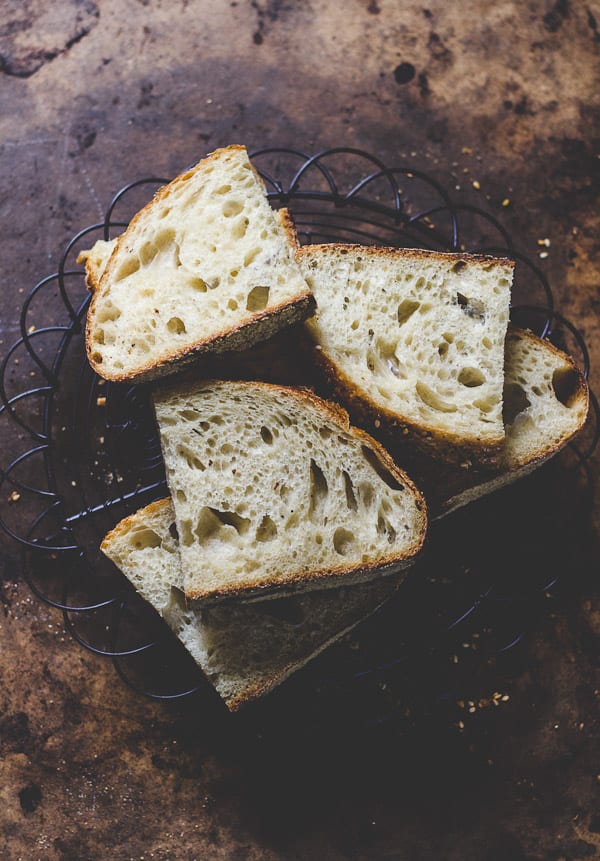
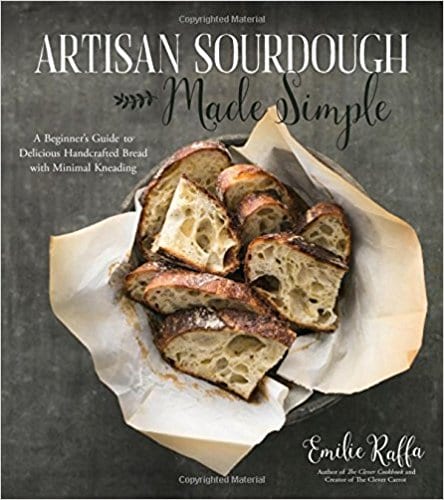

Comments
Michael says
Is 350 g of water correct? It made my bread so sticky. Normal sourdough recipe only calls for 250 g.
Emilie Raffa says
Hi there! Yes, the measurements are correct. The amount of water can vary from recipe to recipe. It’s not set in stone. Bakers do this to achieve different bread styles. However, if you prefer 250g you can use that amount instead- no problem.
Nitika says
Hi! I get very confused with starter hydration math, after baking for more than 4 years! So for this, if I use 50gms whole-wheat , 50 gms bread flour, 100 gms water – how much should the ‘previous’ starter be? also 100gms?
Lucy says
Hi! I’m struggling recently with my loaves and I can’t figure out why! I made your chocolate noir sourdough and it turned out amazing, since I’ve tried both the artisan and this recipe and my loaves have even crumb but are so flat! I’ve tested Dutch oven/steam tray, different oven temperatures. My starter was almost doubled when I used it and the dough rose double overnight. Any other ideas on what I can experiment with??
Laura says
So far every one of your recipes here have been amazing! I particularly love the chocolate noir and walnut raisin (I use figs). I plan to try the dukkah this weekend. I have your book, but have yet to try those recipes because I have a question about the amount of starter. I noticed the recipes in the book use less starter than these online – is there a reason for that? The amount of flour and water seems similar. I’ve had such good luck with the recipes with 150g starter, I’m a bit nervous to try less : )
Thank you!
Laura
Emilie Raffa says
Hi Laura! That’s wonderful to hear, thank you. I get asked this question quite often. Please refer to the FAQ section in my Beginner Sourdough Post for all the details! The amount you use is totally up to you.
Nicole says
I’m also a little iffy about putting my bread overnight in the fridge to rise because the last time I did that the bread (made using your AP flour recipe) came out quite dense? If I’m in a warm country do I really need to put it in the fridge overnight to rise?
Emilie Raffa says
Hi Nicole! You don’t have to refrigerate the dough. This technique is optional if you want to slow down the rise. It’s totally up to you. Regarding dense bread, it could be numerous things: dough was baked before it doubled, over proofed, inaccurate measuring, dough was too cold etc. etc. Retrace your steps and see if anything rings a bell. Hope this helps!
nicole says
Thanks! I ended up refrigerating the dough overnight and it came out beautiful! Once again, your recipes have made my tummy happy. Thank you! :)
Emilie Raffa says
Oh that’s great to hear! Glad it worked out :)
Nicole says
The bread looks amazing!! Can I use an all AP flour starter with this instead of the bread flour and wholegrain starter you used?
Emilie Raffa says
Hi Nicole! You most certainly can. It will be great :)
Ines says
Hi, will it be as good if the second rise is not in the refrigerator?
Emilie Raffa says
Absolutely! It will be great. :)
Thouraya says
Yum! I recently got gifted a jar of Dukkah and was wondering what I can make with it. This is perfect.
I just started my first sourdough starter. I know you say no bread maker is needed but ummm would I be able to use a bread maker? I have one and we’re facing a gas shortage so I can’t use my oven. :(
Emilie Raffa says
Hi there! I haven’t tested the recipe with a bread maker, but I’m sure you can give it a go. Let us know how it turns out :)
Debra Fuller says
Do you have any advice on Sourdough Rye? I’ve had 2 failures. Trying your Dukkah recipe but with Rye starter and just Caraway Seeds in the dough. ? Think it will work better because it has more water in it? We’ll see what happens.
Your Sourdough for beginners is so excellent. I’ve been at this for years and missed Sourdough when I went to baking school. Have made 6 successful rounds. Delicious!!!
Any advice on Rye would be welcome. Thank you so much.
Emilie says
Hi Debra! Thanks so much for your feedback! Okay, so for the rye… would you mind telling me what your challenges are with your current recipe? I think with a little bit more info I can help! Rye can be a little tricky because it does not have as much gluten as regular wheat flour, so just that alone will cause the dough to react differently. I will email you as well just in case you don’t get this! x
Amanda says
Hello, I made your sourdough noir this past weekend and loved it. I made one big loaf. I want to try this dukkah recipe this weekend, but split it into two loaves instead. I want to buy the proofing baskets but I never know what size to buy. What size do you use for a recipe like this, for each half of the dough? Also, do you have any tips for preventing burning on the bottom? My sourdough noir did burn a bit, and also got kind of stuck to the dutch oven. I did use the cornmeal as suggested.
Jessica says
Thank you for the great recipes! I am excited to try this one, but I am worried about the proving in cloth step…. I have tried this on numerous occasions but have never managed to do it without the dough completely sticking to the cloth. Last time I even used way more flour than I thought I would need! Any suggestions?
mardi says
what a gorgeous piece of art that i want to replicate and devour. but i need some help, if you don’t mind? what exactly do you mean by bread flour, is that considered a strong flour? i live in spain and am only able to find wheat and spelt flour (whole and white). and for environmental and health reasons i would prefer to use local organic flour.. i have a sourdough starter that i have been feeding white organic wheat flour. i have yet to make a loaf as i am trying to find the right recipe to work with. what would you suggest i use to achieve your bread here? thank you in advance for your guidance.
Emilie says
Hi there! Bread flour is higher in protein than regular flour or ‘plain flour’. I think your equivalent is either ‘baker’s flour’ or ‘strong flour.’ This type of flour is preferred in bread baking for better gluten development in the bread. It adds excellent structure and texture. However, if you can’t find it, substitute with what you have (white organic wheat flour). The texture will be slightly different, but it’s a good place to start! Good luck! Happy Baking!
Shawna says
I have this bread rising right now. It is beautiful.
I added a bit of the dukkah topping as I did my stretch and folds. I couldn’t help myself.
{Your beginners guide was most helpful to me as I spent months learning sourdough.}
Shawna says
…. I am a bit confused.
When I have seeded the dough, before it’s final rise in the refrigerator, is the seeded side down in the cloth lined basket?
Emilie says
Hi Shawna,
Yes, place the dough seeded side down. Anytime dough goes into a cloth lined basket or banneton, you want the the seam facing up, looking at you. :)
Emilie says
Wonderful! I’m so happy to hear that you are enjoying the sourdough process- isn’t it addicting?! Glad you’ve found the tutorial helpful :)
Hill says
Thank you so much! I have two left hands in the kitchen, I hate cooking. When I am asked to bring something for a school meeting sweat breakes out. Yes I am the one bringing the popcorn… My partner loves to cook, he comes home after a ten hour work day and starts cooking because it relaxes him! I cannot get my head around it, amazing. Then my sister in law showed me how to make sourdough bread and something clicked. Maybe it is the slowness of it all, plus only two or three ingredients and not a whole list that makes me nervous… I browsed the internet to find a recipe I could understand and follow and stumbled on you blog. Can you believe I made my own starter? Then I went on to make the Dukkah bread and wow, I did it!! Thank you so much for explaining it all so clearly, step by step. You definitly made the kitchen a less scary place for me!
Jessica says
Is this made with a 100% hydration starter?
Emilie says
Hi Jessica,
Yes it is. You can read the breakdown method right after the 3rd photo in the post.
gramma4health says
What a gorgeous loaf of sourdough and a beautiful crumb too! Definitely going to try this with home milled flour! Thank you for sharing!
Marie says
Beautiful bread! I love to bake bread too and have never heard of the last part to harden the crust? Must try! This recipe looks delicious…what kind/brand of flour do you like best?
Emilie says
Hi Marie! Yes, if you leave the oven open towards the end of baking, all of the moisture will escape leaving you a nice hard crust. This is particularly helpful when baking with a Dutch oven where there is a lot of moisture. If you are baking on a tray, you probably wouldn’t need to do this. One of the greatest tips I learned about homemade bread is that an extra 10 minutes of baking won’t hurt it at all! As for the bread flour, I like to use King Arthur. I go back and forth between brands based on availability, but they have a very nice product. Hope that helps! Happy baking :)
laurasmess says
I’m rather obsessed with dukkah. And za’atar, and harissa, and everything else vaguely in the Middle Eastern/African category! It’s wonderful with sourdough and I think it’s a brilliant idea to combine the two upon baking Emilie! Gorgeous post – love these photographs, they’re moody and beautiful. Oh, how I wish I was talented at sourdough! xx
Emilie says
Thank you Laura! I’m getting into these sorts of spices myself. You have done some lovely things with them yourself. I think the best part about cooking, is that you never stop learning and discovering… (and eating- ha!) xx
Sherri@The Well Floured Kitchen says
I’ve heard of dukkah, but never really thought about it too much. Looking at the list of ingredients, I know it must be amazing! I will definitely give this a try. Your bread looks amazing with or without the dukkah. Pinned :)
Emilie says
You are so sweet Sherri! Thank you! If you’re in the store, you’ll see that different Dukkah blends will vary, that’s why I like to make my own. You get to have fun and play around until you get it just right. Even if you don’t make this bread, it’s still fun to sprinkle the mix onto roasted veggies, soups, salads, and of course- to dunk! :)
Glenda says
Great looking bread Em and I love the idea of dukkah coating. I am definitely going to try it.
Emilie says
Hi Glenda! So nice to see you here! If you try it, definitely let me know how it goes…. Thanks for stopping by :)
celia says
Em, your loaves are looking amazing! What a great combination of flavours in this one! xx
Emilie says
Thanks love! It was fun to make too- (minus the seeds everywhere…) xx
Alessandra (DinnerinVenice) says
HEAVENLY!!!! Must try!
Georgia @ The Comfort of Cooking says
What a delicious dip for sourdough! This looks like such a yummy combination, Emilie. Great recipes and photos!
Emilie says
Hi Georgia! Thank you SO much :)
Adri says
WOW!! This sounds so good – crunch, flavor, and such wonderful texture. You make the most beautiful and tempting breads. This one is completely new to me, and it sounds great. Also, once again, I have to compliment you on your beautiful and very instructive photographs. Bravissima!
Emilie says
Thank you so much Adri :) I do love to bake bread very much- once you get going, finding your own personal rhythm and style, it’s hard to give up. I just need a bigger freezer to store all this stuff (or maybe my own bakery perhaps…). The dukkah crust gives this bread a unique flavor boost and is quite delicious. Whether you make this bread or not, I think you will like this spice blend! xx
JJ - 84thand3rd says
I’m quite obsessed with Dukkah these days as well – I love the idea of coating bread in it and then dunking again once baked ;D
Emilie says
I know… I see all your your yummy IG pics with dukkah ;) It’s fun to play around with, isn’t it?
Sandra says
Wow…just beautiful!!! Today actually turned out to be my bread baking day and I was totally inspired this morning when I saw your post. I didn’t have everything I needed for the dukkah so I went with a toasted sesame loaf that actually includes them inside and out. It might just be my new favorite…I’m guessing until I try your dukkah (next on the list) Do you think you could incorporate some of the mixture into the dough? The sesame seemed to do just fine both inside and out.
I really feel like I have to get all my bread baking out of the way now because there is no way I’m turning my oven on that high in the middle of summer. It is going to kill me to have to buy bread :(
Emilie says
Thanks Sandra! I saw your bread last night on FB- just beautiful! You could absolutely incorporate the dukkah into the dough. Because there are a lot of nuts and seeds in it, I would soak the amount that you want to add to the dough first (I usually do this during autolyse). You don’t need to soak your topping. Does that make sense? So, I guess just divide it up before you begin! I can’t wait to see what you come up with. :)
I’m totally with you on not baking in the summer… I’m not really sure how that is going to be possible though, because once you get used to the good stuff it really is way too hard to buy it. Ugh. I stock up as much as I can now, but honestly, we just end up eating it all. I need one of those freezer chests…
Sandra says
Yes a chest freezer…it is on my list of things to get! But like you said…I’m sure it doesn’t help too much ;)
Emilie says
Oh good… if you find a nice one let me know! xx
Laura (Tutti Dolci) says
What a gorgeous bread, this would not last long in my kitchen!
Emilie says
I know- here too! We’re just ripping chunks off left and right… ;)
Pamela says
I was on Safari twice in South Africa an never got to experience this! I feel robbed!! I love the sound of it, especially on crusty bread! It reminds me very slightly of kimmelweck rolls in Buffalo, New York.
Emilie says
Ooo, twice?! That’s awesome. Which one(s) did you do? We visited the Addo Elephant Park- it was so beautiful. We saw everything. I can’t believe that you’ve never tried dukkah while you were there! It was interesting because every time we had it, it was slightly different. Now you can make it to your liking at home! Enjoy :)
Mimi says
Beautiful bread! And double the dukah! love it.
Emilie says
Thank you Mimi! It’s such a different way to enjoy dukkah… We made grilled cheese with it last night with thick slices of tomato. It was delicious! :)